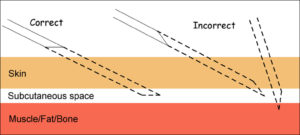Principles for using vaccines
Vaccinations are cheap insurance against stock losses. Pestivirus, tick fever, botulism, vibrio and other clostridial diseases (in descending order) are in the top 15 livestock diseases of economic importance in Australia. It is highly recommended that all cattle receive 5-in-1 or 7-in-1 and all bulls receive vibrio annually. Vaccinate against pestivirus if your herd is at risk. If you are unsure of the best vaccination program for your herd contact your veterinary practitioner. Always follow manufacturer’s instructions when vaccinating. All injections should be given under the skin in the neck, not in the muscle.
Live and killed vaccines
Killed vaccines are a mix of dead pathogens (e.g. minced up virus particles or bacteria) and compounds called adjuvants which stimulate the development of immunity. Water-soluble adjuvants are preferred, but sometimes oily adjuvants are used to get enough stimulation. This extra stimulation can cause prolonged site reactions if you don’t inject properly.
Live vaccines have altered organisms to cause immunity but not disease. They do not generally have adjuvants.
Primers and boosters
To be effective killed vaccines usually require two initial injections, the first primer injection followed by the booster given at least four weeks apart. If the second shot (booster) is not given, there is every chance that no protection will be provided. If the booster is delayed for up to four months after the primer, it is likely that some animals will receive protection, though not at the same level as they would have if they had been given the booster at the recommended time. However, some killed vaccines (for example, two of the available botulism vaccines) require only one initial shot.
Most live vaccines require one initial shot but there are exceptions; for example, the bovine ephemeral fever (BEF or three-day sickness) vaccine requires the same protocol as for killed vaccines.
After the initial shots, annual booster shots are required for most live and killed vaccines to sustain protective immunity.
Vaccinate at the right time
Vaccinate animals before they are likely to be exposed to the disease but as close as possible to the likely period of transmission. For example, vaccinate bulls for vibrio at least 10 weeks before mating and vaccinate heifers about six weeks before mating.
It is difficult to vaccinate calves, but they do require protection. They can get this from antibodies in the colostrum immediately after birth. Maximise the levels of antibodies in the colostrum by giving breeders their annual vaccinations before calving. Diseases like pestivirus can spread during mating and vaccination before calving is strongly recommended in herds where this disease is a problem.
Avoid vaccinating cattle with wet coats as this increases the chance of infection at the injection site.
Giving multiple vaccines
Some vaccines can interfere with the development of immunity from other vaccines if they are given at the same time. For example, avoid giving tick fever (blood) at the same time as any initial (priming) injections; however this vaccine can be given at the same time as boosters.
Vaccines based on gram negative bacteria (this includes most of the bacterial vaccines) can cause toxicity problems (endotoxins) in some cattle if given with multiple vaccines. Avoid giving more than two bacterial vaccines at the same time.
Hit the right spot, gently
Even when given properly, all vaccines can cause significant reactions and pain, to the point of lameness in some animals, for up to a week. A swelling will be seen on most animals at the injection site in the days after injection.
Most vaccines for cattle should be given under the skin, especially oil-based vaccines. Severe reactions can occur if you inject the vaccine into muscle. The preferred site is above the backbone in the neck area forward of the hump. Injecting here minimises the potential for carcase damage.

Your needle should be sharp and clean and be inserted as gently as possible. The best needles are capped but these are only available in ¾ inch; ½ inch needles would be ideal if they were available.
The anal fold is an UNACCEPTABLE site for vaccination; there are too many nerves, blood vessels and opportunities for infection, and this site is next to several valuable meat cuts.
Avoid injecting more than one vaccine into the same site. Before vaccinating a group of cattle, determine where you’ll inject each vaccine, for example either side, forward or back of the neck area.
Handle vaccines for effectiveness and safety
Vaccines should be treated like milk. Vaccines exposed to freezing, heat or light can break down and become ineffective. The sterile packaging means vaccines can have a much longer shelf-life than milk, but they must be kept refrigerated. Once a pack is open, its sterility is lost. Opened vaccines that are kept chilled and clean can still be used within a week. Refrigeration must be maintained crush-side during vaccination.
Use clean gear. Disassemble, clean, sterilise and reassemble re-usable guns between each use. Replace disposable guns after use.
Don’t miss the animal and get yourself. A 16 gauge needle hurts. If you inject yourself with vaccine it can cause nasty prolonged reactions. It is VERY important that you do not accidently inject anyone with an oil-based vaccine as it can cause very serious reactions requiring surgery and cause significant permanent damage.